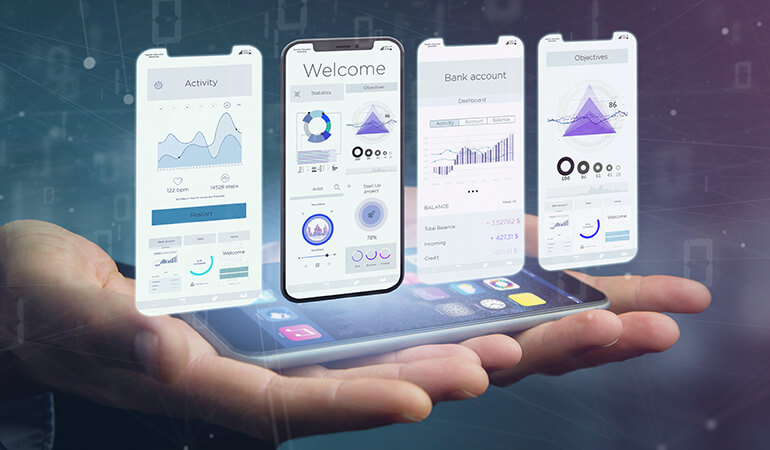
In 2025, the mobile app ecosystem has entered a new phase with the proliferation of 5G, the rise of foldable devices, and the integration of AR/VR technologies. As the global mobile app economy is expected to reach $935 billion, a mobile-first strategy has become not an option but a necessity for businesses. In this article, we'll examine modern mobile app development approaches, cross-platform frameworks, native and hybrid strategies, and emerging mobile technology trends in detail.
Platform Choice: Native vs Cross-Platform vs Hybrid
Native Development
Separate codebases for iOS and Android:
iOS Development (Swift/SwiftUI)
- Advantages: Maximum performance, platform-specific features, optimal UX
- Disadvantages: High development cost, need for two separate teams
- Use cases: Performance-critical apps, gaming, AR/VR applications
Android Development (Kotlin/Jetpack Compose)
- Advantages: Wide device support, flexible customization, open ecosystem
- Disadvantages: Fragmentation issues, test complexity
- Use cases: Enterprise applications, IoT integration, custom hardware
Cross-Platform Frameworks
Single codebase, multiple platforms:
Flutter (Google)
- Dart programming language
- Hot reload feature
- Rich widget library
- Near-native performance
- Strong community support
React Native (Meta)
- JavaScript/TypeScript
- Extensive npm ecosystem
- Native module support
- Code push capability
- Mature framework
.NET MAUI (Microsoft)
- C# and .NET ecosystem
- Enterprise-ready
- Windows, macOS support
- Blazor hybrid apps
- Strong tooling
Kotlin Multiplatform Mobile (KMM)
- Shared business logic
- Native UI
- Gradual adoption
- Type safety
- Android-first approach
Modern Mobile Architectures
Clean Architecture for Mobile
Layered approach:
- Presentation Layer
- View (UI components)
- ViewModel/Presenter
- State management
- Navigation logic
- Domain Layer
- Use cases
- Business rules
- Domain models
- Repository interfaces
- Data Layer
- Repository implementations
- Data sources (local/remote)
- Mappers
- Cache strategies
State Management Patterns
Modern state management approaches:
- BLoC Pattern (Flutter)
- Redux/MobX (React Native)
- MVVM (Native)
- MVI (Model-View-Intent)
- Riverpod (Flutter 2.0+)
Mobile Backend as a Service (MBaaS)
Cloud-native backend solutions:
Firebase (Google)
- Real-time database
- Authentication
- Cloud functions
- Push notifications
- Analytics and Crashlytics
- Remote config
- App distribution
AWS Amplify
- GraphQL API (AppSync)
- Authentication (Cognito)
- Storage (S3)
- Analytics (Pinpoint)
- ML services integration
Supabase (Open Source Alternative)
- PostgreSQL database
- Real-time subscriptions
- Row level security
- Edge functions
- Vector embeddings
Mobile DevOps and CI/CD
Automated build and deployment processes:
CI/CD Platforms
- Bitrise: Mobile-specific CI/CD
- Codemagic: Flutter specialist
- GitHub Actions: Integrated workflow
- FastLane: Automation toolchain
- App Center: Microsoft's end-to-end solution
Testing Strategies
- Unit testing
- Widget/Component testing
- Integration testing
- E2E testing (Appium, Detox)
- Performance testing
- Accessibility testing
Mobile Security Best Practices
Secure mobile app development:
Code Level Security
- Code obfuscation
- Certificate pinning
- Anti-tampering measures
- Secure storage (Keychain/Keystore)
- Biometric authentication
- App shielding
Data Protection
- End-to-end encryption
- Secure communication (TLS 1.3)
- Data minimization
- GDPR/KVKK compliance
- Secure backup strategies
Runtime Protection
- Jailbreak/Root detection
- Runtime application self-protection (RASP)
- Anti-debugging techniques
- Memory protection
- API security
Performance Optimization
Mobile app performance improvements:
App Size Optimization
- Code splitting
- Lazy loading
- Asset optimization
- ProGuard/R8 (Android)
- App thinning (iOS)
- Dynamic feature modules
Runtime Performance
- Image caching strategies
- Network optimization
- Database indexing
- Background task management
- Memory management
- Battery optimization
Startup Time Optimization
- Cold start improvement
- Splash screen optimization
- Lazy initialization
- Preloading strategies
- App launch profiling
Emerging Technologies and Trends
Leading mobile technologies in 2025:
5G Integration
- Ultra-low latency applications
- Edge computing
- Enhanced mobile broadband
- Massive IoT connectivity
- Network slicing
AR/VR Capabilities
- ARCore/ARKit integration
- WebXR support
- Spatial computing
- Mixed reality experiences
- 3D content creation
AI on Device
- TensorFlow Lite
- Core ML
- On-device training
- Privacy-preserving ML
- Neural engine utilization
Foldable and Multi-Screen
- Adaptive layouts
- Continuity features
- Multi-window support
- Drag and drop
- Screen spanning
Mobile Analytics and User Insights
Understanding user behavior:
Analytics Platforms
- Google Analytics 4
- Mixpanel
- Amplitude
- Segment
- Custom event tracking
Key Metrics
- Daily/Monthly Active Users (DAU/MAU)
- Retention rate
- Session duration
- Crash-free rate
- App store ratings
- Conversion funnel
A/B Testing
- Feature flags
- Remote configuration
- User segmentation
- Gradual rollout
- Statistical significance
Monetization Strategies
Mobile app revenue models:
Revenue Models
- Freemium
- Subscription (SaaS)
- In-app purchases
- Advertisement (AdMob, Facebook Audience)
- Paid apps
- Hybrid models
Payment Integration
- Apple Pay/Google Pay
- Stripe/PayPal SDKs
- Cryptocurrency payments
- Regional payment methods
- Subscription management
App Store Optimization (ASO)
App store visibility:
ASO Strategies
- Keyword optimization
- Title and description
- Screenshots and videos
- Localization
- Review management
- A/B testing store listing
Accessibility and Inclusivity
Accessible apps for everyone:
Accessibility Features
- Screen reader support
- Dynamic type
- Color contrast
- Voice control
- Haptic feedback
- Gesture alternatives
Future Roadmap: 2025-2030
Mobile technologies in the next 5 years:
Super Apps
- All-in-one platforms
- Mini program ecosystems
- Cross-service integration
Blockchain Integration
- Decentralized apps (dApps)
- NFT integration
- Crypto wallets
- Smart contracts
Quantum-Safe Security
- Post-quantum cryptography
- Quantum key distribution
- Secure communication
Conclusion
Successful mobile app development in 2025 requires more than just writing code—it demands a perfect balance of user experience, performance, security, and business objectives. With the maturation of cross-platform frameworks approaching native performance and the integration of technologies like 5G and AR/VR, mobile app development is becoming even more exciting. Businesses can develop competitive mobile apps that deliver value to users through proper platform selection, modern architectural approaches, and continuous optimization.